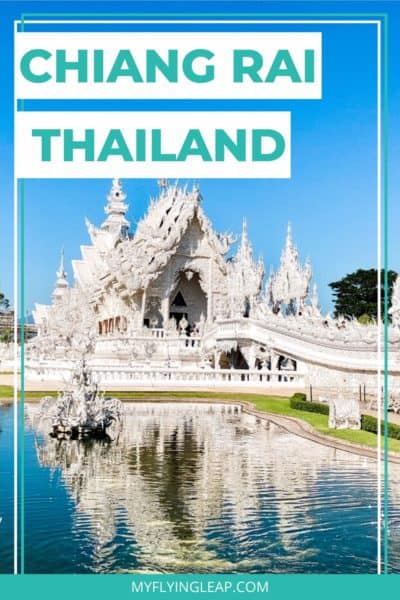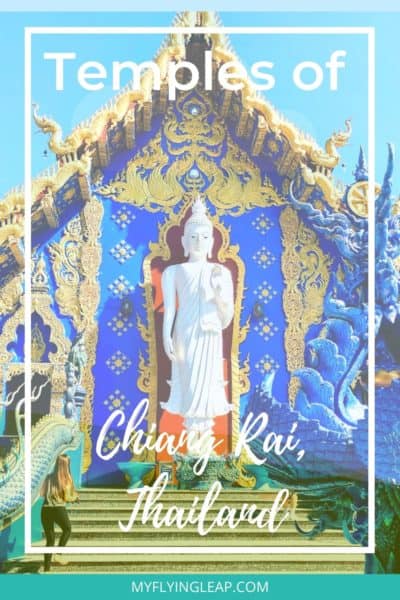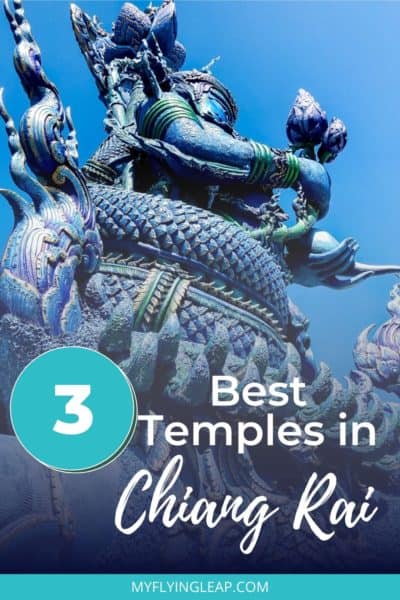Chiang Mai to Chiang Rai Day Trip & Top Chiang Rai Temples to Visit
A Chiang Mai to Chiang Rai day trip is a popular way to see unforgettable temples in Chiang Rai.
Chiang Mai is a top tourist destination in Thailand and with good reason. It offers a quaint historic center packed full of beautiful temples, and it’s well-situated to visit the northern areas of Thailand.
A Chiang Mai to Chiang Rai is a popular way to visit several world-famous temples in the small city of Chiang Rai. This post shares information about these temples, what you will do on a typical tour of the area, and why you should plan a day trip to visit.

This post may contain affiliate links, which means I’ll receive a commission if you purchase through my links at no extra cost to you. Please read the full disclosure for more information.
Chiang Mai to Chiang Rai Day Trip Tour with a Small Group
You have a number of options to get from Chiang Mai to Chiang Rai on a day trip, and a small group tour is one of the best of them. Especially if you’re limited on time or want to be able to sit back and not navigate transportation.
I chose to take a small-group tour to go from Chiang Mai to Chiang Rai to avoid dealing with transportation hassles. It’s also a good way to see some other things in the area.
This tour took us to the three famous temples in Chiang Rai. Additionally, we went to visit the Karen, a native tribe in the area, and the Golden Triangle.
I booked the trip through Tripadvisor and chose Journey Travel. I don’t see them listed any longer, which is too bad, though I see many other options, including small group tours, a private tour, and even a two-day tour if you want to see more of Chiang Rai.
This trip is somewhere I recommend taking a small-group tour to visit. If you are staying in the old town of Chiang Mai, it’s very difficult to find parking, so having a car there is an inconvenience. You can certainly rent a car from Chiang Mai if you choose.
Though, I love going on day trips like this with a guide as you learn so much from them. And added bonus: no trying to find your way around (which, for me and my total lack of any sense of direction, is very challenging!).
Typical Chiang Mai to Chiang Rai Day Trip & My Experience
The van picked me up at my guest house just after 7 a.m. I was impressed that the van made it down my incredibly narrow road in the old town of Chiang Mai. My guide was named Nui, and he was wonderful.
We stopped to see some hot springs, which were more of a tourist ‘trap’ for people to sell their wares. A large, basic complex surrounded two small geyser-like hot springs.
I got breakfast (50 baht, or around $1.60 USD) of pork and greens stir fry with rice. It turned out to be spicy and really good.
After a short break, we were on our way to one of the highlights of this trip, the White Temple.
You May Also Like Top Things to Do on a Chiang Mai Itinerary
Stop 1: White Temple
The drive took a little over 2.5 hours to get to the White Temple, Wat Rong Khun. To say it was incredibly beautiful and impressive is an understatement, but words are tough to find that seems appropriate enough.
It was built around 20 years ago and opened to the public. More than 2,000 people a day visit it, and there were at least that many when we went. Though the weather is best during the dry season, tourists flock to areas in Thailand, including Chiang Rai.
If you do have the opportunity to stay in Chiang Rai overnight, it’s worth doing so if for no other reason than to get an early start to visit the White Temple. It was crowded and incredibly packed with people.
Temple is a bit of a misnomer. The White Temple is a privately owned art exhibit styled like a Buddhist temple. It’s owned by a man named Chalermchai Kositpipat, who actually designed and coordinated its construction. Then, he opened it to visitors in 1997.
It was built on the site of an original temple, also called Wat Rong Khun, that had fallen into disrepair. This local artist rebuilt the temple, funding it himself.
He is also building a center of meditation and learning for people, and the temple is an offering to the Buddha he created in the hope of immortal life. I guess we shall see if it worked.

Visiting Wat Rong Khun
First, take some pictures of this stunning masterpiece with 2,000+ of your new best friends. If you’re patient, you may luck out and get some times when fewer people are in front of it.
Taking it in from a distance is impressive, but when you get up close, you realize how much detail and intricacy went into this building.
The Bridge of the Cycle of Rebirth
You walk over a bridge to the main building in the White Temple, symbolizing a bridge to heaven. We were told you should only go one way over the bridge, and that’s to get to heaven.
When you look down from the bridge, you see a sea of hands reaching up to the sky. Perhaps they didn’t listen to the guidance and went the wrong way.
These hands symbolize unrestrained desire, and the path to happiness over the bridge is by forgoing greed, desire, and temptation.


Gate of Heaven
Once you cross the bridge, you arrive at the large gate of heaven guarded by two creates representing Death and Rahu. It’s Rahu who decides the fate of the dead. Here, you can see several images of Buddha in meditation.
Ubosot
The main building has fragments of mirrored glass embedded in the exterior walls. Inside, it begins as a pristine white with a life-like wax replica of the Dalai Lama.
The scene quickly shifts to fiery scenes with both colors. Murals on the walls depict demon faces, orange flames, nuclear warfare, and destruction.
The symbolism seems to suggest a rather heavy statement on human morality, and the structure represents the mind and the idea of shifting focus to the mind instead of worldly possessions.

The Golden Building
There are several different buildings and structures on the property, all of which are rather ornate. One that stands out is a golden building representing the body, and the gold symbolizes people’s focus on worldly desires and money.
Interestingly, and I’m not sure of the symbolism for this, it’s actually the bathroom. What do you think that is intended to say?

There are a lot of interesting things to see on the grounds. One of my favorites was a life-sized statue partially reclining on a bench of what looked almost like a Spiderman figure.
Then, there were the uber-creepy trees with heads hanging from the branches.


The White Temple is located at 1 Phahonyothin Rd, Pa O Don Chai, Mueang Chiang Rai District, Chiang Rai 57000, Thailand. It’s open from 8 to 5 Monday through Friday and from 8 to 5:30 on Saturday and Sunday. It costs 50 baht to visit ($1.60 USD).
Stop 2: Blue Temple
Another beautiful temple in Chiang Rai is the Blue Temple, or Tiger Dancing Temple, Wat Rong Suea Ten. This temple isn’t as well known as the White Temple, and though it’s smaller in size, it’s no less beautiful.
It is much less crowded than the White Temple, and it’s as fascinating, detailed, and intricate as the carvings at the White Temple are. I favored the Blue Temple. I liked the distinct and bright colors, and it just seemed to give off a much lighter and more positive feel.
The story about this temple being called the Tiger Dancing Temple is that tigers used to be in the area, and this temple was built to represent their playing and dancing.
It was also stunning, with its gorgeous cobalt color and intricate designs. Though it is a Buddhist Temple, it is not a working temple, and no monks live onsite.
The Blue Temple fell into a state of disrepair at the beginning of this century, and it was completely rebuilt and completed in 2016. Putha Kabkaeu, a student of the creator of the White Temple, Chalermchai Kositpipat, designed the project.


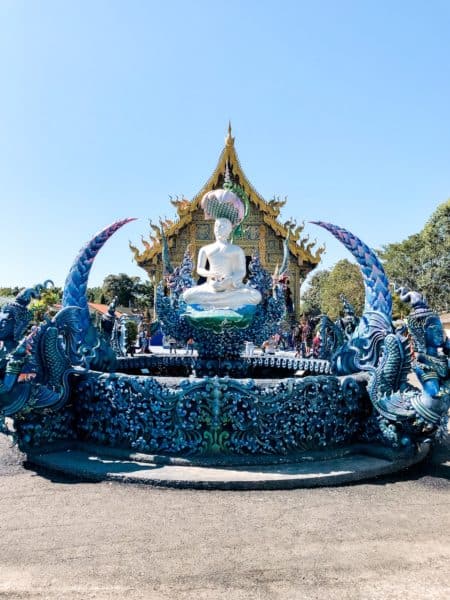
Main Building
Large Naga snakes guard the entrance of the assembly hall or viharn. There is a lot of intricate and beautiful detailing of the floral motifs decorating the doorway in the traditional Lanna style. It’s the same striking blue as all of the buildings on the property, adorned with a lot of gold.
When you enter the building, you immediately notice the large white image of the Buddha straight ahead. There are two rows of pillars also decorated with intricate motifs, paintings depicting scenes from the life of Buddha, and ornaments in vibrant colors. The room is striking and as beautiful as the adorned exterior.
Please respect people who worship here and avoid areas reserved for the monks. You should leave your shoes outside before entering the Blue Temple.
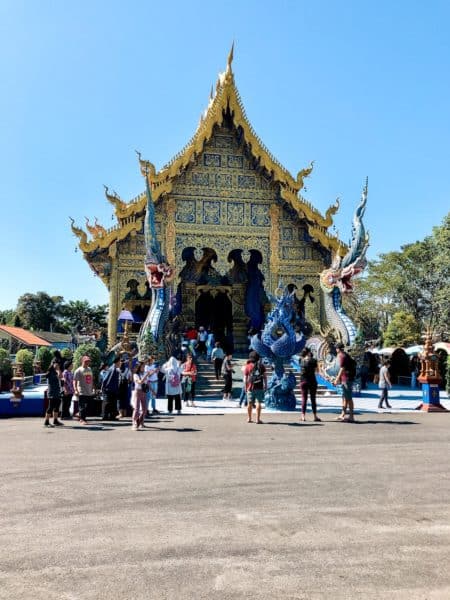

Other Structures on the Grounds
Behind the building is a Buddhist stupa, also called a chedi. It’s a blue and gold structure on a square blue base. There is also a bell tower and several white images of the Buddha sitting on blue pedestals.
There’s also a small water feature in front of the main building and two large, gorgeous statues worth seeing when you enter the grounds. Take it all in—the separate features are stunning, and the overall view is simply spectacular.
The Blue Temple is located at 2 Maekok Rd, Rim Kok, Mueang Chiang Rai District, Chiang Rai 57100, Thailand. It is open from 7 a.m. to 8 p.m. daily, and entry is free.

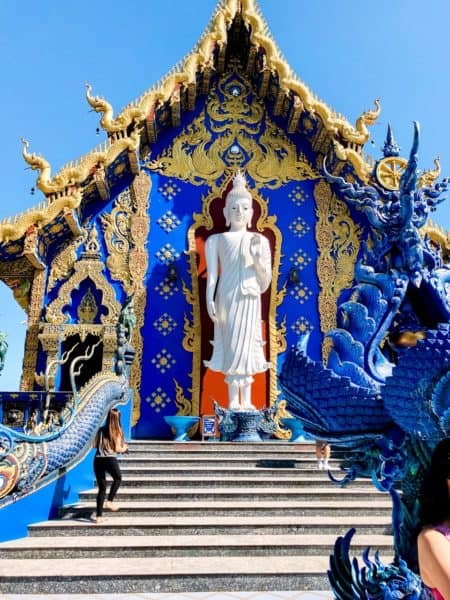

Stop 3: Black House
Last was the Black House, or Baan Dam Museum, a portrayal of hell designed by artist Thawan Duchanee. It’s a collection of 15 black buildings sparsely decorated with various animal remains like snake skins and an elephant skeleton supposedly from natural causes.
It gives off a strange kind of tribal vibe that evokes conflicting emotions when you view it.
The main building is a large wooden structure with a tiered roof featuring curving metal points that poke out from the sides. Inside are tables with various animal remains and a table with a long snakeskin.
The remaining buildings are all much smaller and no less strangely decorated. Some of the buildings are open for touring, while others are to be viewed from the outside only.
There is a strangely-shaped building that looks like a submarine. You can peer into the windows to see what appears to be a torture chamber. Where the White Temple was designed to represent heaven, this depiction of hell seems quite fitting.
It’s primarily black, or at least gives off a dark aura, and each one of the 15 houses is embellished and furnished with animal remains. It was the oldest and was built 40 years ago. The artist recently passed.
The Black House is located at 13 Baan Dam Museum, Nang Lae, Mueang Chiang Rai District, Chiang Rai, Thailand. It is open from 9 to 5 daily and costs 80 baht ($2.60 USD).



Stop 4: Long-Neck Karen Tribe
The “long-neck Karen,” or Kayan, are indigenous hill tribes from Burma, modern-day Myanmar. They fled the country in the late 1980s and early 1990s to the northern lands of Thailand. Three villages are currently open to tourists who survive on the income they receive from visitors.
According to tradition, females wear neck rings starting at the age of five, and every 2 to 3 years, another ring is added. They were initially made of gold, though they were substituted with brass due to the threat of injury from the gold.
The most rings women wear are around 34, and they are quite heavy. They make the body shorter by pushing down the collarbone and giving the appearance of extending the neck.
Traditionally, all women wore them, though now they have a choice. (Having said that, girls start to wear them at the age of five, so I’m not sure it’s really a matter of the child’s choice.)
According to legend, this began to protect women from tigers. It’s unknown if there is any truth to that story, and others are also told.
They are also seen as making women look more beautiful, which may factor into the decision to wear them. When asked, many women say they wear them for cultural identity.
We were told that it is a lifetime commitment to wear them as women can die if they are removed. However, I read that some women remove the rings for various reasons.
After many years of wearing them, the muscles weaken, and there is often significant bruising and discoloration. Though wearing the rings is often discouraged in Myanmar, it has provided a source of income and has gained popularity in northern Thailand.



Should You Visit the Kayan Tribe?
I’ll be honest: I was a bit torn about this visit. On one hand, it was quite interesting to see the women and girls and to get to talk with them through a translator.
On the other, it was very clearly a set-up to collect tourist dollars, and I wonder how much goes to the women and girls who are impacting their bodies so dramatically. I suspect more money goes to the villagers or the tour guides than to them.
In retrospect, I probably wouldn’t have gone were this not a stop on the tour I went on. I might have looked for a different tour instead. I do find it quite fascinating, but I do not like supporting activities that promote the mistreatment of women and girls.
If you choose to visit, the Long-Neck Karen Tribe village is located at 6 Nang Lae, Mueang Chiang Rai District, Chiang Rai 57100, Thailand.
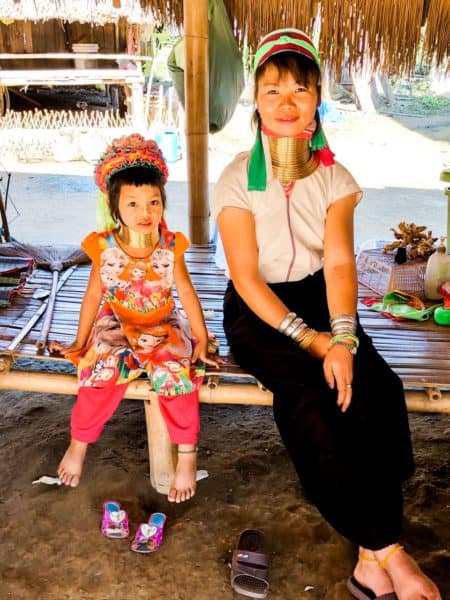
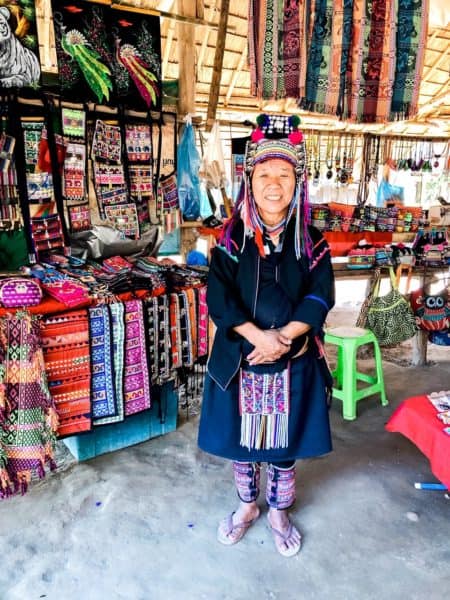
Stop 5: Golden Triangle
Last, we drove another hour or so to the “Golden Triangle.” Few places have as much notoriety as this area and Chiang Rai, formerly known for the opium trade. The CIA named it as it was one of the largest opium-producing regions in the world.
Until as recently as the early 21st century, most of the world’s heroin was supplied from here. (Now that “honor” belongs to Afghanistan and the “Golden Crescent.”) However, it did start to transition around 30 to 40 years ago, and the local farmers grow coffee, which is prevalent in shops throughout Thailand.
The “Golden Triangle” is the mountainous region where the Ruak and Mekong Rivers meet at the borders of Thailand, Myanmar, and Laos. There are several statues and some information to read along the river about the area’s history. There are several shops and stores that are, of course, happy to sell you things, as well as some small restaurants and food carts.
If you’re an animal lover, this area, and northern Thailand in general, will break your heart. A very friendly dog came up to me and started rubbing my leg. I was doing my best not to pet the dogs on this trip due to a potential risk of rabies (a series of 15 shorts just doesn’t sound very appealing!)
However, this one pet me, so I thought it would be ok. She also got a bit of my dinner, so we were both pleased.
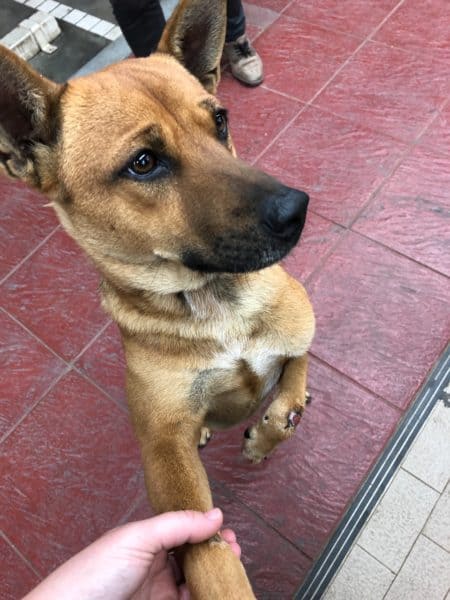
Boat Ride to Laos
We boarded a longboat and went across the river to Laos. (Note: you do need your passport! My tour didn’t share this piece of information, though. Thankfully, they did allow me to go with my driver’s license.)

Though it’s interesting to see this famed area, it’s a HUGE tourist trap. The section of Laos that you visit is some large buildings packed full of everything you could possibly want (and not want) to buy. Designer knock-offs, souvenirs, clothes, etc.
I noticed a rather foul smell just after getting off the boat, and for some strange reason, people were gathering around where it was the strongest. It turned out they were selling some offensively-smelling liquor with snakes, spiders, and the like in it, offering samples.
I swear I can still smell this disgusting odor when I close my eyes and think of this visit. No, thank you!
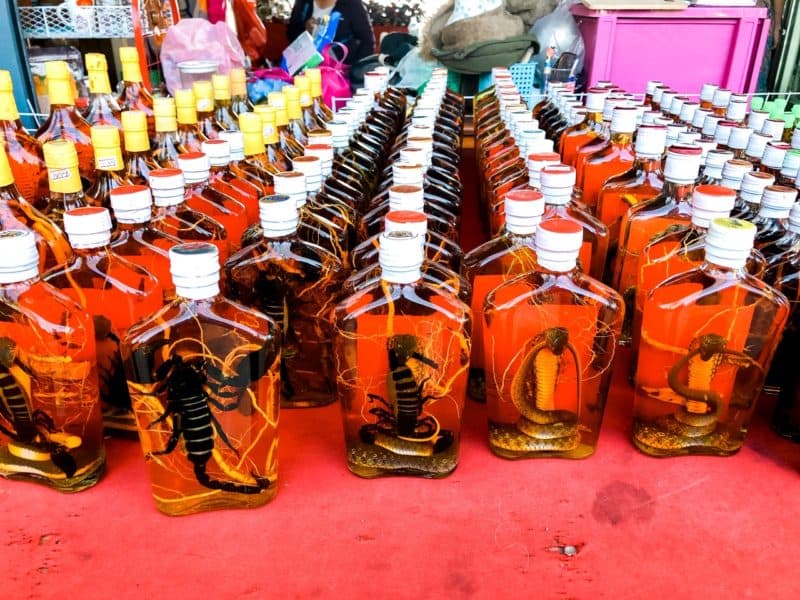
Transportation to the Chiang Rai Temples
The easiest way to visit the temples from Chiang Rai is to take a tuk-tuk or a taxi. There are options as well for a bicycle or small motorbike. And last, there are also tours from Chiang Rai. A public bus in Chiang Rai goes to the White Temple but does not go to the other two.
To visit from Chiang Mai to Chiang Rai, you can also get a taxi driver or take a tour. Each temple is around 5 to 10 miles apart from the other (approximately 10 to 15 km).
There are several tour options from Chiang Mai to Chiang Rai to choose from, including private and group tours. There are also some options from Chiang Rai if you choose not to deal with transportation while you’re there.
Some of these also include visiting the long-neck Karen tribe and the Golden Triangle. So, take a look at what’s available and find the tour that best meets your interests.
Dress Code
When you enter temples anywhere in Thailand, and for that matter, in Southeast Asia, respectful attire is expected. This means covering knees and shoulders and not wearing tight or skimpy clothing.
It’s a good idea for women to bring a wrap if you’re unsure if your clothing covers enough. If you’re seeking other tips for visiting Thailand, check out this post.
Why You Should Take a Chiang Mai to Chiang Rai Day Trip
If you’re looking for a fun adventure exploring northern Thailand and getting to see a wide assortment of things, a Chiang Mai to Chaing Rai day trip may be just the thing for you. It’s a long day as a one-day trip, but it’s so much fun!
You Might Also Like
- The Best Places to Visit in Thailand
- 20 Things to Know Before You Go to Thailand
- Top Things to Do on a Chiang Mai Itinerary
- Tok Sen Massage—a Northern Thailand Experience
- Best Thailand Animal Sanctuary—Elephant Nature Park
- The Best 2-Day Itinerary in Bangkok
- Why You Should Visit Lumphini Park in Bangkok
- Krabi Sunset Cruises—Best Thailand Cruise
- My Thai Paradise—Ban Sainai Resort in Krabi
Like it? Pin it!
